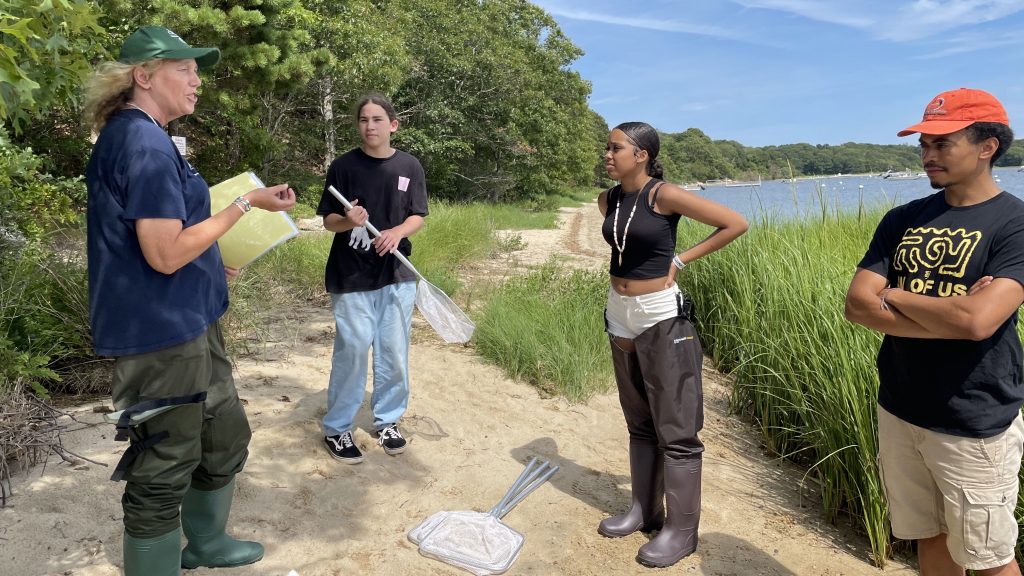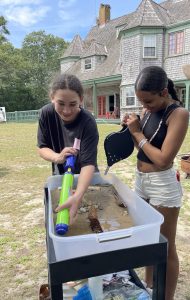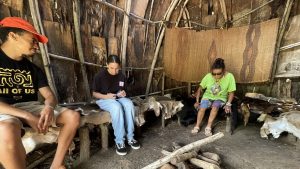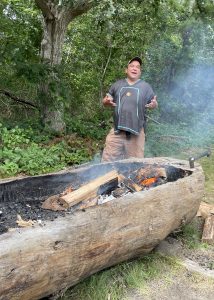From Classrooms to Coastlines: Young Innovators Shape Sustainable Futures

This spring a small group of middle school students from Mashpee gathered in their school’s Indian Education room at lunchtime to meet with a group of educators from UMass Boston. The educators, who included Asa Peters, a graduate of UMass and a member of the Mashpee Wampanoag Tribe, were recruiting students from the Mashpee Wampanoag Tribe to participate in a course to design sustainable shorelines, using a range of approaches including traditional ecological knowledge.
The course is part of a WHOI Sea Grant-funded project, led by Bob Chen of University of Massachusetts Boston, Lois Hetland of Massachusetts College of Design, and Cedric Woods of the Institute for New England Native American Studies, that is looking to develop resilience to climate change and transform communities over time. The project engages middle and high school students in a course to design a shoreline, blending art, design, engineering, science, and local knowledge in their work.
Last year ten students from East Boston engaged in the course, and this July, the research team expanded the project to a second location in Mashpee.
“We want the students to understand all the factors that go into designing sustainably by the shore,” said Aimee Bonanno, an education program manager in Chen’s lab at UMass Boston, “anticipating the effects of climate change on sea level rise, coastal erosion and built landscapes.”
Ultimately, five students were chosen for the Mashpee class, which met at the tribal headquarters as well as in locations by the shore. The goal for the students is to design their own shoreline project, with the aim of sustainability for seven generations out – an important Wampanoag concept.
Over the course of four weeks, the teaching team led the students through the design cycle, delivering information in layers while developing connections to their local shorelines.
“They’re engaging, thinking about it,” said lead teacher Asa, “soaking in what we’re talking about.”
During field trips to local shorelines, the students visited the Waquoit Bay National Estuarine Research Reserve, where the Mashpee tribe has established a traditional domed hut or “wetu” made from cedar saplings, bark, and cattail reeds.
There, they heard from Kitty Hendricks, an educator with the tribe, who described how female hollow-tubed cattails were cut in half and woven into mats covering the roof of the wetu – their tubes forming natural channels to shed rain off the hut. She also told stories of seasonal migration from the wetus by the shore in the summer, where quahogs and oysters were central to the diet, to winter wetus inland, insulated with animal furs including deer, which was a core food item in the cold months.
Alongside the wetu, the students worked with Darius Coombs, a culture and outreach coordinator with the tribe, to build a mishoon – a traditional wooden boat made of white pine. Over two weeks the canoe is hollowed out with a continuous fire, and the ash scooped out with a clam shell until the canoe is ready to be used.
Walking along the shoreline, the students could see coastal erosion and a small oyster aquaculture farm there. They also waded into the water with nets to explore the animals living by the shore and saw some of the science projects that have been established at WBNERR to study the problem of excess nitrogen in water.
As their first introduction to thinking about how structures made by the water survive, the class went to nearby Punkhorn Point and used material they found on the shore to build small structures such as rock towers and stick structures fastened with grasses. “They had to think through the design process and consider how structures would last through tidal cycles,” said Aimee. “On a return trip a few days later, they could see the rock structures had moved – sometimes quite far. Stick structures lasted a little better.”
The class will reconvene in September and hopefully meet with the students from East Boston. Next steps for the Mashpee students will be to work as a team to conceive of and draw a plan, leaning into both tradition and innovation while taking the environmental risks and adaptations into account.
“I’m hoping the opportunity to learn in this program plants a seed–something they’ll reflect upon when they’re a little older,” said Asa. “I think in two or three years, maybe they’ll rise up in youth leadership activities – tribal groups or environmental activities. I hope they can draw upon the experience as they mature or when they want to assume a bit of responsibility.”
Through this program, the program aims to equip students with a newfound understanding of the design process and the factors involved in developing sustainable shorelines, and the confidence to present their ideas to their broader community.



